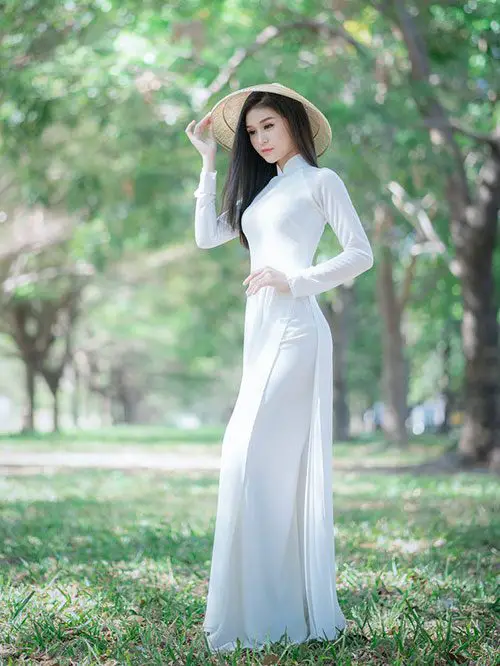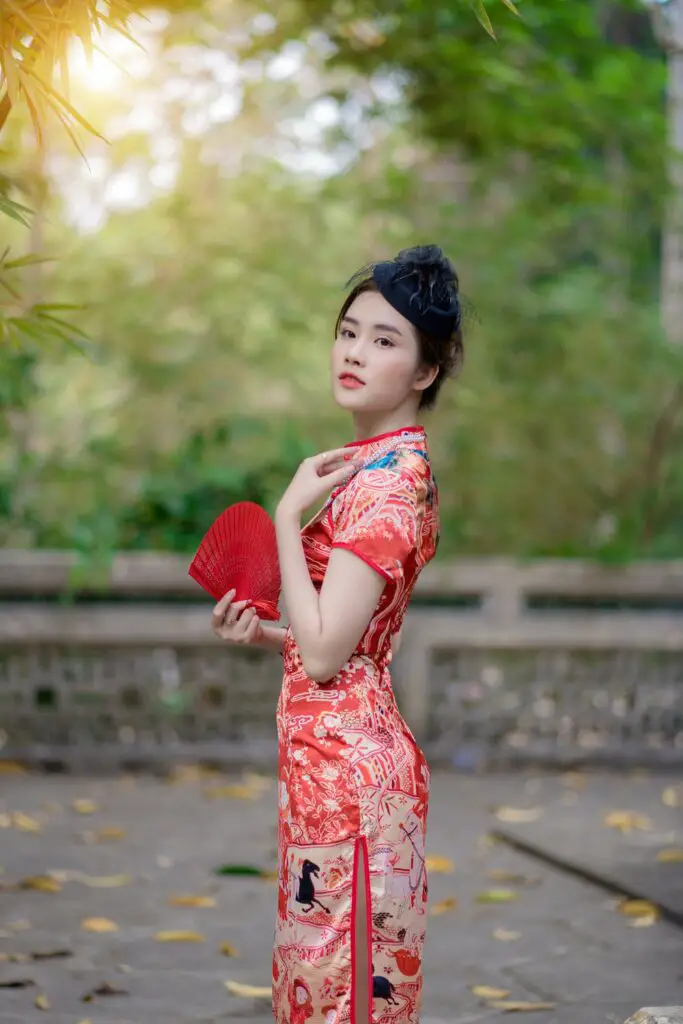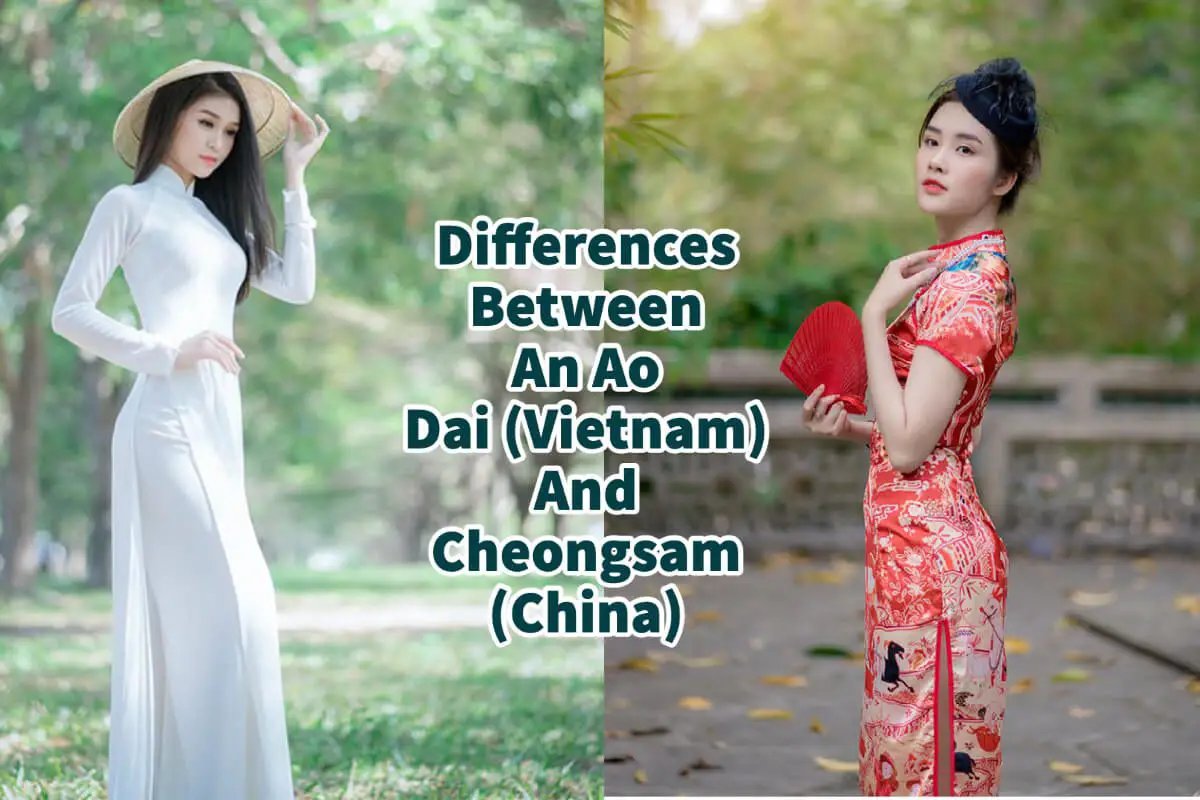Looking at Asian women’s dresses, there can be some confusion between the Vietnamese Ao Dai and the Chinese called Cheongsam. These classic Asian dresses have some similarities but also many differences.
The Vietnamese Ao Dai is a long, flowing Vietnamese-like dress that splits up both sides, with flowing white pants underneath and a mandarin-style collar. The Ao Dai usually also has long sleeves. The Chinese cheongsam is the Chinese dress that most Westerners associate with China. The dress usually has short sleeves, a mandarin collar, and a split-up on one side of the dress. The Ao Dai and Cheongsam have fallen in and out of politics. Today, they are both traditional dress symbols of each nation.
Table of Contents
- Comparing the Vietnamese Ao Dai and the Chinese Cheongsam: Distinct Traditional Dresses
- Differences Between the Ao Dai and Cheongsam Asian Women’s Dresses
- Related Questions
Comparing the Vietnamese Ao Dai and the Chinese Cheongsam: Distinct Traditional Dresses
Exploring traditional Asian fashion often brings up the Vietnamese Ao Dai and the Chinese Cheongsam, two classic dresses that, while similar in some aspects, exhibit distinct differences.
The Ao Dai, emblematic of Vietnamese heritage, is a long, form-fitting tunic with a split on both sides, typically paired with flowing white trousers and a mandarin collar, often featuring long sleeves. On the other hand, the Cheongsam, a symbol of Chinese culture, is recognized for its snug fit, short sleeves, mandarin collar, and side slit that characterizes its design.
These dresses have navigated various cultural and political landscapes, evolving over time. Today, they are traditional representations of their respective nations, each with a unique style and cultural significance.
The Vietnamese Ao Dai Traditional Dress
If you ever attend a Vietnamese wedding or another special event in Vietnam, you will find that many women at the wedding party wear what is known as the traditional Vietnamese Ao Dai.

The Vietnamese Ao Dai is a long gown with long sleeves, a mandarin-style collar, and a split to the waist, worn with flowing white trousers underneath; it has long been a symbol of Vietnamese women’s grace and beauty. The Vietnamese Ao Dai holds a place of pride in Vietnamese women’s hearts.
Even school girls will wear their lovely white Ao Dai. The Ao Dai is written in Vietnamese as “Áo dài.” The Vietnamese word “Áo” means a shirt, and “dài” means long, so it is translated to mean a long shirt.
The Ao Dai as we know it today underwent several revisions until, in the 1920s and 1930s, some Hanoi fashion houses, inspired by the Paris fashions, redesigned the traditional dress of the Ao Dai.
Even this version from the 1930s has undergone some revisions. In the 1950s, some Saigon fashion designers tightened the fit of the ao dai or long shirt to a version that the women are wearing today. In fact, in the 1960s and 1970s, the ao dai dress for women was trendy in South Vietnam.
In North Vietnam when the Communists took control of North Vietnam in 1954, the Ao Dai became controversial. Many felt the dress was considered decadent and a symbol of Western power.
In the 1980s, the Ao Dai started to gain popularity all over Vietnam when the Vietnamese state enterprises and schools began to adopt the Ao Dai as a uniform. In 1995, the Miss International Beauty Pageant in Tokyo gave Truong Quynh Mai, the Vietnamese contestant, the “Best National Costume” award; the Ao Dai became extremely popular in Vietnam.
Today, this Ao Dai dress continues to be very popular, and almost every Vietnamese woman will have at least one Ao Dai in her closet that she can bring out for special occasions.
The Chinese Cheongsam Traditional Dress
The Chinese Cheongsam is a Chinese dress that most Westerners associate with China. It is a long, tight-fitting dress with a short sleeve, a slit up one side of the dress, and a mandarin collar.

The Cheongsam is also known as the qipao; it is considered the national dress of Hong Kong. Many Westerners see the cheongsam as a Chinese dress, but the reality is that the dress is a mix of Chinese and Western clothing styles.
The Cheongsam dress first appeared in China after the collapse of the Qing Dynasty in 1911. When the Qing Dynasty collapsed, China, which had been isolated from the rest of the world for a long time, started to modernize quickly.
Women began to feel more freedom in their dress and clothing but did not want to adopt an utterly Western-style dress. The cheongsam became a compromise between China and the Western ways the Chinese quickly adopted.
The Cheongsam used traditional Chinese fabric like silk with the conventional Chinese collar, but the tight-fitting style was distinctly Western. The cheongsam quickly became famous as a symbol of modern China and the mixing of the East and West.
In China, famous actresses and other personalities wear tight-fitting cheongsams with high heels. Many of these pictures would be considered provocative.
When the Communist Party took control of China in 1949, the once-famous cheongsam quickly faded. By 1966, the ruling Communist party had banned the dress. But in neighboring Hong Kong, the dress was never forbidden and never went out of style.
In fact, in Hong Kong in the 1950s and 1960s, the cheongsam was very popular as it symbolized Hong Kong’s resistance to the many changes that were taking place in Communist China.
Today, you may find some Chinese women wearing cheongsam for traditional gatherings such as weddings or Lunar Chinese New Year celebrations.
Differences Between the Ao Dai and Cheongsam Asian Women’s Dresses
The Vietnamese Ao Dai dress and the Chinese Cheogsamm dress use mandarin collars and split up the sides of the dress. Both are also form-fitting dresses designed in the early 1900s with Western influences.
But even with those similarities, they are very different dresses and came about differently. The French fashion houses inspired Vietnam’s Ao Dai to design a traditional Vietnamese dress that was distinctly Vietnamese with some Western influences.
The Ao Dai splits up both sides of the dress, and Vietnamese women will always wear pants under the dress. The dress is form-fitting at the top until the waist, then the ao dai will flow down, making it easy to walk with.
The Ao Dai usually has long sleeves and intricate embroideries on the dress. The pants under the Ao Dai are not tight-fitting but are baggy, so they look almost like a long skirt. The pants under the Ao Dai top are usually white.
The Chinese cheongsam is also a tight-fitting dress, but unlike the Ao Dai, it has short sleeves; the cheongsam does not have any pants under it. The cheongsam has a split-up side and is usually made with Chinese-style silk fabric.
Both of these dresses are important to the countries they come from. The Vietnamese Ao Dai is a symbol of a Vietnamese dress, and the cheongsam is a symbol of a Chinese women’s dress.
At A Bus On A Dusty Road, we discuss everything about culture, travel, life, sailing, and ex-pat living. We are all about “Living Life As A Global Citizen.” We explore social, cultural, and economic issues and travel.
We would love to have you be part of our community. Sign up for our newsletter to keep up-to-date by clicking here. If you have any questions, you can contact me, Anita, by clicking here.
Listen to our Podcast called Dusty Roads. You can find it on all major podcast platforms. Try out listening to one of our podcasts by clicking here.
Subscribe to our A Bus On A Dusty Road YouTube Channel filled with great videos and information by clicking here.
Related Questions
14 Things To Understand The Vietnamese Culture
Vietnam is a magical country to visit or live in. The Vietnamese people are kind, generous, and inviting to foreigners. But anyone planning a visit to Vietnam should understand some things about Vietnamese culture.
By clicking here, you can discover 14 Things To Understand The Vietnamese Culture.
Is the Vietnamese Water Puppet Show Worth Seeing?
Every visitor to Vietnam should go to see the Vietnamese Water Puppets show. This water puppet show is very much a part of Vietnamese culture. The water puppets are also a rich part of Vietnam’s history.
By clicking here, you can discover Is the Vietnamese Water Puppet Show Worth Seeing?
Traditional Vietnamese Clothing Before The Ao Dai Dress
Before the early 1900s, Vietnam did not have the Ao Dai as we know it today. In fact, like many things in Vietnam, there were times in Vietnamese history when dress and clothing were used as a political statement or to separate one part of Vietnam from another.
To find out more, you can read our blog on Traditional Vietnamese Clothing Before The Ao Dai Dress by clicking here.


